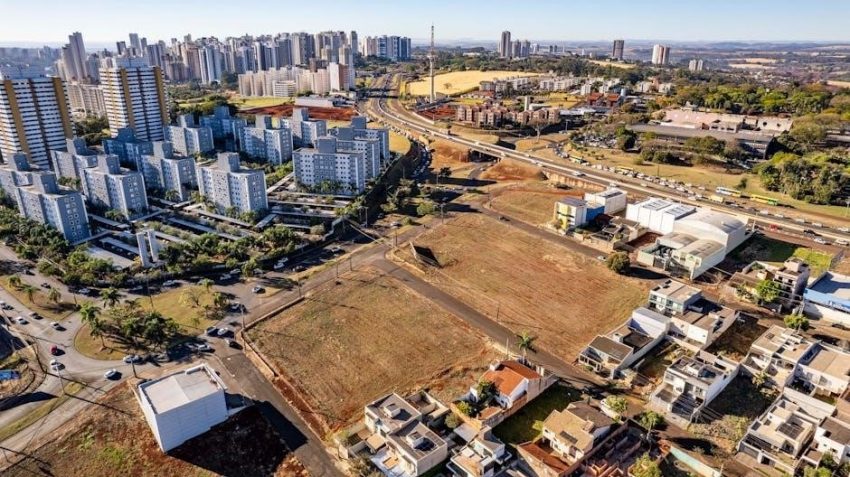Traffic generating developments refer to land uses or projects that significantly impact traffic flow‚ requiring careful planning to mitigate congestion and ensure safety. This guide provides updated frameworks for assessing traffic impacts‚ emphasizing sustainable growth and efficient transportation systems.
Updated in 2023‚ the guide offers comprehensive strategies for traffic management‚ including parking solutions‚ access design‚ and safety measures. It serves as a vital resource for urban planners‚ engineers‚ and policymakers to address modern transportation challenges effectively.
1.1 Definition and Overview
Traffic generating developments are land uses or projects that produce significant traffic volumes‚ impacting road networks and requiring detailed planning. They include commercial‚ residential‚ and industrial developments that attract vehicles‚ pedestrians‚ and freight movements.
The guide defines these developments and outlines considerations such as parking demand‚ access design‚ and safety. It provides frameworks for assessing traffic impacts to ensure sustainable and efficient transportation systems‚ aiding urban planners and engineers in managing growth effectively.
1.2 Importance of Traffic Generating Developments
Traffic generating developments play a crucial role in economic growth by attracting businesses‚ creating jobs‚ and fostering urban expansion. They influence land use patterns‚ transportation infrastructure‚ and community accessibility. Understanding their impact is essential for planning efficient transportation systems‚ ensuring safety‚ and enhancing quality of life. Proper management of traffic generating developments balances economic benefits with environmental and social considerations‚ minimizing congestion and accidents while supporting sustainable urban growth.
1.3 Key Considerations in Traffic Generation
Key considerations in traffic generation involve assessing traffic volume‚ peak hour demands‚ and infrastructure capacity to accommodate growth. Land use patterns significantly influence traffic flow‚ necessitating harmonization between residential‚ commercial‚ and industrial areas. Public transportation availability can mitigate traffic congestion by reducing reliance on personal vehicles. Additionally‚ pedestrian and cyclist traffic must be integrated into plans to ensure safety and accessibility. Environmental impacts‚ such as emissions and noise‚ should also be evaluated to promote sustainable development. Finally‚ incorporating smart technologies can enhance traffic management efficiency.
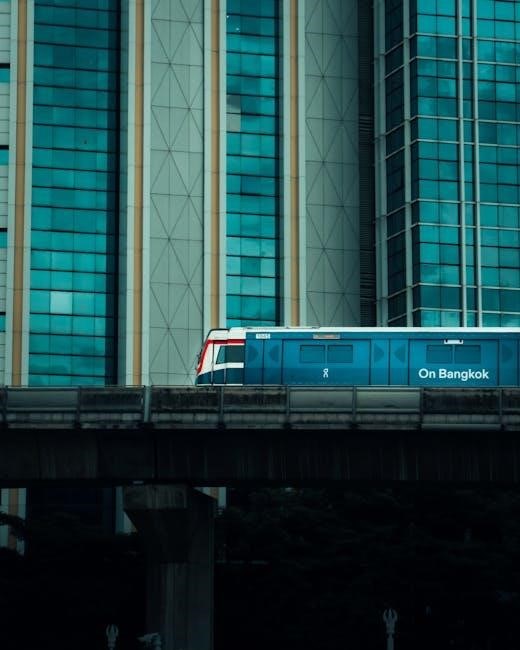
Understanding Traffic Generation Principles
Understanding traffic generation principles involves analyzing traffic flow dynamics‚ movement patterns‚ and interactions between transportation modes to optimize network efficiency and user experiences effectively.
2.1 Fundamentals of Traffic Flow
Traffic flow fundamentals involve understanding the movement of vehicles‚ pedestrians‚ and other modes of transport within a network. Key elements include traffic volume‚ speed‚ and density‚ which determine the efficiency of transportation systems. The relationship between these factors is crucial for predicting and managing traffic behavior. Traffic flow theories‚ such as the hydrodynamic analogy‚ explain how traffic behaves like fluid‚ with variations in flow rates and congestion points. Accurate measurement and analysis of these dynamics are essential for designing effective transportation infrastructure and optimizing mobility in urban and rural areas.
2.2 Trip Generation Rates and Analysis
Trip generation rates measure the number of trips produced by land uses‚ such as homes‚ offices‚ or retail spaces. Analysis involves identifying trip patterns‚ including origins‚ destinations‚ and peak times. Factors like location‚ land use type‚ and accessibility influence trip rates. Accurate data is critical for transportation planning‚ ensuring infrastructure design aligns with demand. Understanding trip generation helps balance accessibility with capacity‚ minimizing congestion and enhancing mobility. Advanced tools and models are used to forecast future trip demands‚ supporting sustainable development strategies.
2.3 Impact of Land Use on Traffic Generation
Land use significantly influences traffic generation‚ as different activities attract varying volumes of trips. Mixed-use developments reduce the need for lengthy commutes‚ lowering traffic. High-density areas often generate more traffic due to concentrated activity‚ while low-density areas may lead to urban sprawl and increased car dependency. Proximity to public transport and pedestrian-friendly designs can mitigate traffic by reducing reliance on personal vehicles. Understanding land use patterns is crucial for predicting traffic volumes and designing efficient transportation networks to accommodate demand.
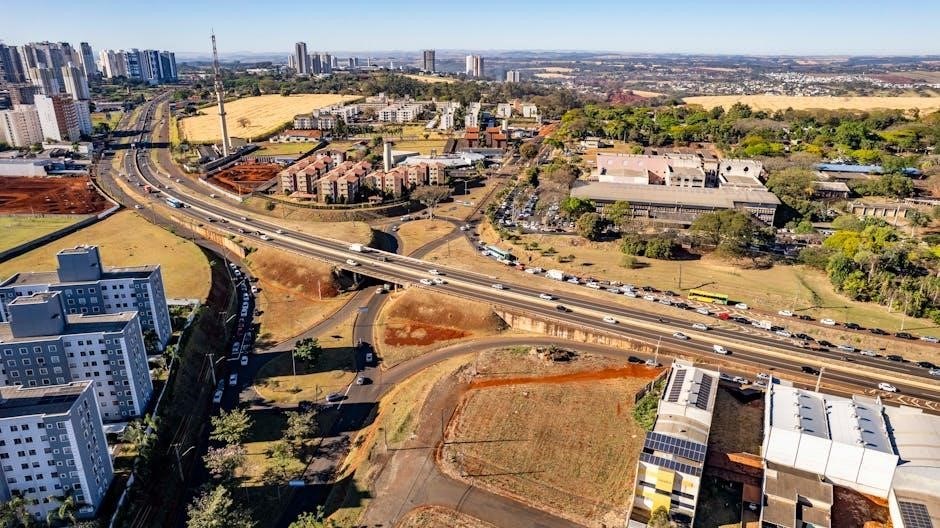
Transportation Planning and Engineering
Transportation planning and engineering are vital for creating efficient traffic systems. They involve designing infrastructure and integrating public transport to optimize traffic flow and reduce congestion effectively.
3.1 Principles of Transportation Planning
Transportation planning principles focus on creating safe‚ efficient‚ and sustainable systems. They emphasize accessibility‚ connectivity‚ and equity‚ ensuring all communities can benefit. Key aspects include integrating land use and transport‚ promoting multimodal options‚ and adapting to future demands. Data-driven approaches‚ like traffic analysis and public engagement‚ guide decision-making. Sustainability is central‚ balancing economic‚ social‚ and environmental needs. These principles aim to reduce congestion and enhance overall quality of life through well-designed infrastructure and policies.
3.2 Network Development and Traffic Management
Network development and traffic management focus on designing and optimizing transportation systems to handle existing and future demands. This involves creating interconnected roadways‚ public transit routes‚ and pedestrian pathways. Effective traffic management uses tools like signal timing‚ dynamic traffic routing‚ and real-time monitoring to minimize congestion. Smart technologies‚ such as traffic sensors and AI algorithms‚ enhance efficiency and safety. The goal is to create balanced networks that reduce travel times‚ improve accessibility‚ and support sustainable urban growth while accommodating diverse transportation needs.
3.3 Traffic Signal Optimization Techniques
Traffic signal optimization techniques aim to improve traffic flow efficiency and reduce congestion by adjusting signal timing based on real-time conditions. These methods include dynamic signal control‚ adaptive traffic signal systems‚ and coordination between intersections. Advanced technologies like traffic sensors‚ cameras‚ and AI algorithms analyze traffic patterns to optimize signal phases. This ensures smoother traffic movement‚ reduces delays‚ and enhances safety. Regular updates and maintenance of signal systems are essential to adapt to changing traffic demands and minimize bottlenecks in urban areas.
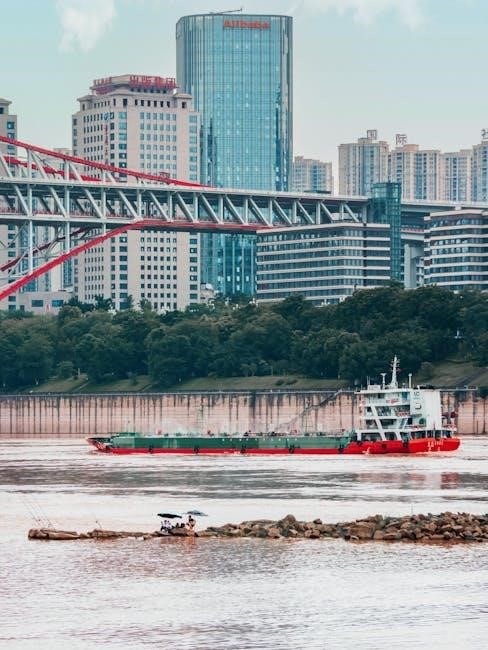
Land Use and Urban Planning
Land use and urban planning strategies influence traffic generation by designing communities that reduce vehicle dependency. Mixed-use developments and compact urban designs promote walking and cycling‚ decreasing traffic demand while improving accessibility and sustainability.
4.1 Land Use Policies and Traffic Generation
Land use policies significantly influence traffic generation by shaping development patterns. Zoning regulations‚ density controls‚ and mixed-use allowances guide how land is utilized‚ impacting travel demand. Policies that promote compact‚ walkable communities and mixed-use developments reduce the need for lengthy commutes‚ lowering traffic volumes. Additionally‚ incentives for transit-oriented development encourage public transport usage‚ further mitigating traffic generation. Effective land use policies balance economic growth with sustainable transportation goals‚ ensuring urban areas are designed to minimize congestion and environmental impact while fostering livable communities.
4.2 Mixed-Use Developments and Traffic Reduction
Mixed-use developments combine residential‚ commercial‚ and recreational spaces‚ reducing the need for lengthy commutes. By locating amenities near housing‚ these developments decrease vehicle trips‚ lowering traffic generation. They promote walking‚ cycling‚ and shorter drives‚ fostering more sustainable transportation habits. Additionally‚ mixed-use projects encourage a sense of community and reduce urban sprawl‚ which are key factors in mitigating traffic congestion. This approach aligns with urban planning goals to create compact‚ livable cities with enhanced accessibility and reduced reliance on personal vehicles‚ contributing to overall traffic reduction and environmental benefits.
4.3 Urban Design Strategies for Traffic Mitigation
Urban design plays a crucial role in reducing traffic congestion by creating pedestrian-friendly and bikeable environments. Strategies include narrowing road widths‚ implementing one-way streets‚ and designing grid networks to distribute traffic evenly. Public spaces and green areas are integrated to encourage walking and social interaction‚ reducing reliance on vehicles. Pedestrianized zones and transit-oriented developments further minimize traffic by promoting alternative modes of transportation. These design approaches enhance livability while effectively mitigating traffic generation and improving overall urban mobility.
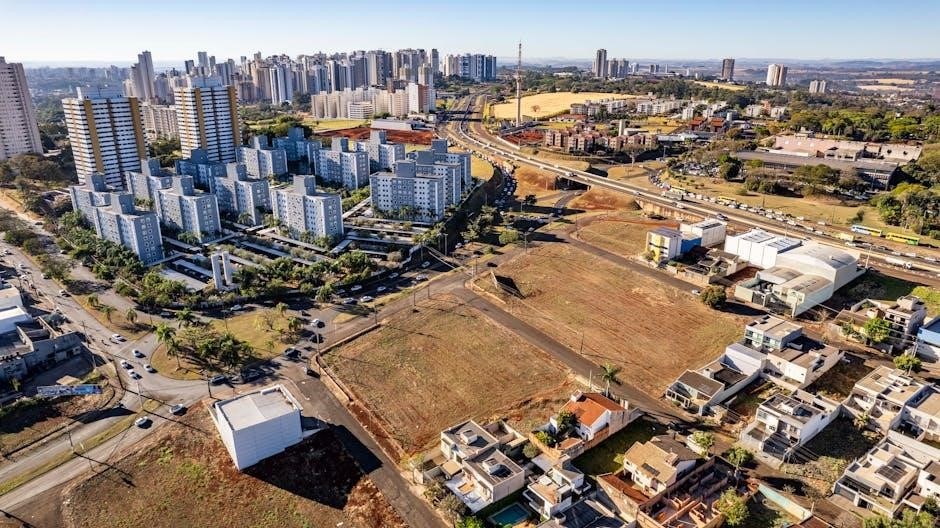
Parking Solutions and Management
Efficient parking solutions reduce traffic congestion by optimizing space and demand. Strategies include demand analysis‚ smart technologies‚ and design safety to enhance accessibility and minimize traffic impact.
5.1 Parking Requirements and Demand Analysis
Parking requirements and demand analysis are critical for ensuring sufficient parking spaces while minimizing traffic impact. Factors like land use‚ traffic volume‚ and user type are assessed to estimate demand.
Advanced methodologies‚ such as traffic studies and occupancy surveys‚ help planners accurately determine parking needs. This ensures efficient space allocation‚ reducing congestion and enhancing accessibility for users.
5.2 Smart Parking Technologies
Smart parking technologies leverage IoT sensors‚ real-time data‚ and mobile apps to optimize parking efficiency. Sensors detect occupancy‚ guiding drivers to available spots via digital maps. Automated payment systems reduce congestion. AI predicts demand‚ adjusting pricing dynamically. These solutions minimize traffic caused by circling for parking‚ lowering emissions and improving urban mobility. Integration with traffic management systems enhances overall network performance‚ making cities smarter and more sustainable. Smart parking is a key tool in modern traffic generating developments.
5.3 Parking Area Design and Safety Considerations
Parking area design must prioritize visibility‚ lighting‚ and pedestrian pathways to ensure safety. Clear signage and intuitive layouts help drivers navigate efficiently. Adequate lighting reduces theft and accidents‚ while emergency access points prevent bottlenecks. Designing parking areas with future expansion in mind ensures long-term functionality. Safety measures‚ such as surveillance cameras and emergency call systems‚ enhance user confidence. Proper drainage and pavement quality prevent hazards like flooding or potholes. Thoughtful planning minimizes risks and improves overall traffic flow in urban environments. Safety and accessibility are critical in modern parking design.
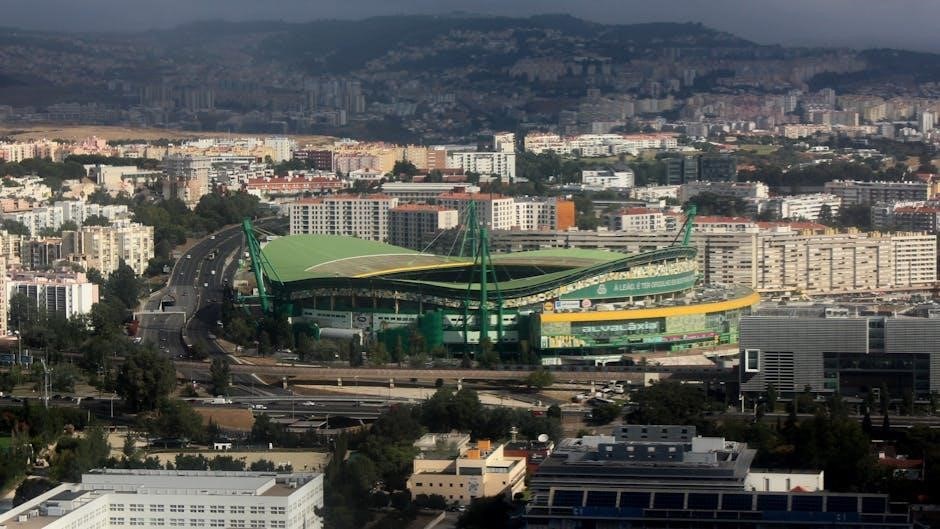
Public Transportation and Traffic Generation
Public transportation reduces traffic by providing efficient alternatives to private vehicles‚ lowering congestion and emissions. Strategic planning ensures accessibility‚ promoting sustainable urban mobility and reducing traffic generation.
6;1 Role of Public Transport in Reducing Traffic
Public transport serves as an efficient alternative to private vehicles‚ significantly reducing traffic congestion. By providing reliable and accessible services‚ it minimizes the reliance on personal cars‚ lowering emissions and improving air quality. Effective public transport systems encourage shared rides‚ decreasing the number of vehicles on the road. This reduction in traffic not only alleviates urban congestion but also supports sustainable urban development by promoting walkable and bikeable communities. Integrating public transport with land use planning further enhances its impact‚ creating livable cities with reduced traffic generation and improved quality of life for residents.
6.2 Integration of Public Transport with Land Use
Integrating public transport with land use ensures efficient travel patterns and reduces traffic generation. Mixed-use developments near transit hubs minimize the need for lengthy commutes‚ lowering vehicle reliance. Transit-oriented development (TOD) strategies cluster housing‚ offices‚ and retail around stations‚ promoting walkability and reducing traffic demand. By aligning land use with public transport networks‚ cities can create compact‚ connected communities that prioritize sustainable mobility over car dependency‚ fostering environmental and economic benefits while enhancing urban livability.
6.3 Enhancing Public Transport Accessibility
Enhancing public transport accessibility is vital for reducing traffic generation. Improving service frequency‚ reliability‚ and coverage ensures that public transport becomes a convenient option for commuters. Affordable fares‚ integrated ticketing systems‚ and real-time information further encourage its use. Prioritizing accessibility for all‚ including disabled individuals‚ ensures inclusivity. Well-designed stations and stops with clear signage and amenities also boost ridership‚ making public transport a preferred choice and alleviating traffic pressures in urban areas.
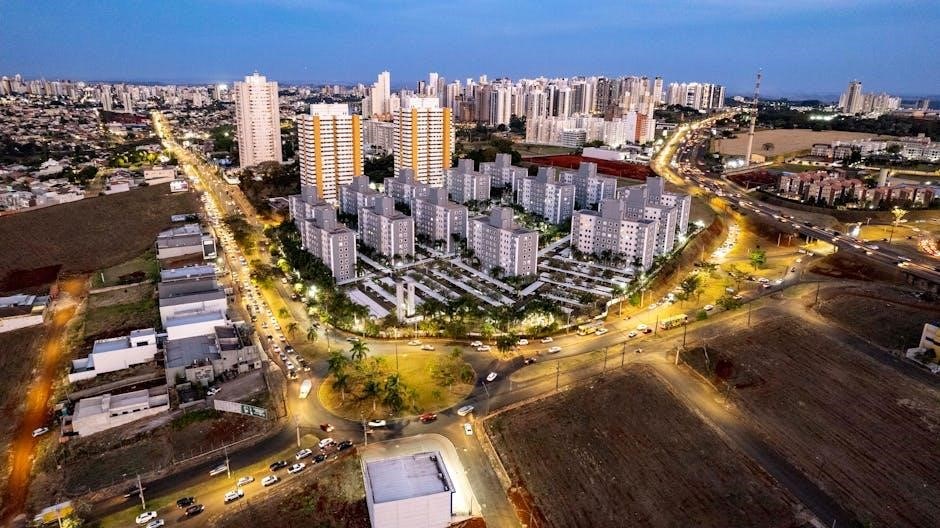
Traffic Safety and Risk Management
Traffic safety and risk management are critical to minimizing accidents and enhancing road security in traffic-generating developments‚ ensuring safer environments for all road users and pedestrians.
7.1 Road Safety Analysis and Assessment
Road safety analysis involves evaluating traffic patterns‚ collision data‚ and infrastructure to identify potential hazards; It includes assessing traffic volume‚ speed limits‚ and pedestrian movements to reduce accident risks. Advanced tools like traffic conflict techniques and simulation modeling predict safety issues before they occur. Regular assessments ensure compliance with safety standards‚ while continuous monitoring helps adapt to changing traffic conditions. This proactive approach minimizes hazards‚ protecting all road users and enhancing overall traffic flow efficiency in developed areas.
- Focuses on data-driven insights to improve safety.
- Includes infrastructure evaluation and user behavior analysis.
- Essential for long-term traffic management planning.
7.2 Traffic Safety Implications of Developments
Developments significantly influence traffic safety by altering traffic patterns and volumes. Commercial and residential projects can increase vehicle and pedestrian interactions‚ raising accident risks. Land-use changes often lead to new safety challenges‚ such as higher speeds or poor visibility. Mixed-use developments‚ while convenient‚ can complicate traffic flow. Ensuring safe access points‚ adequate lighting‚ and clear signage is crucial. Proactive planning helps mitigate risks‚ fostering safer environments for all road users while supporting sustainable growth.
- Development types impact traffic safety differently.
- Increased traffic volume raises accident potential.
- Proactive measures reduce risks and enhance safety.
7.3 Mitigating Traffic Safety Risks
Mitigating traffic safety risks involves strategic planning and design. Improving infrastructure‚ such as adding pedestrian crossings‚ traffic signals‚ and bike lanes‚ enhances safety. Traffic calming measures like speed bumps and roundabouts reduce vehicle speeds. Implementing intelligent transportation systems (ITS) provides real-time monitoring and incident response. Regular maintenance of roadways and signage further minimizes hazards. Collaboration between engineers‚ urban planners‚ and policymakers ensures comprehensive safety solutions.
- Infrastructure improvements enhance safety.
- Traffic calming measures reduce accident risks.
- Technology and maintenance play key roles.
Traffic Congestion and Its Implications
8.1 Causes and Effects of Traffic Congestion
Traffic congestion arises from population growth‚ urbanization‚ and increased vehicle ownership. It leads to delays‚ fuel waste‚ and heightened emissions‚ impacting productivity and air quality significantly.
8.2 Strategies to Alleviate Traffic Congestion
Effective solutions include expanding public transit‚ implementing intelligent traffic systems‚ and promoting carpooling. These strategies reduce vehicle numbers and optimize road usage efficiently.
8.3 Economic and Environmental Impact of Congestion
Congestion increases operational costs‚ raises travel times‚ and elevates emissions. It burdens economies and ecosystems‚ necessitating sustainable urban planning and infrastructure improvements.
Traffic congestion arises from various factors‚ including rapid population growth‚ urbanization‚ and insufficient infrastructure. High vehicle ownership rates‚ poor road network design‚ and increased commuter activity exacerbate the issue. The effects of congestion include prolonged travel times‚ reduced productivity‚ and heightened driver frustration. It also leads to increased fuel consumption‚ higher emissions‚ and greater wear on vehicles. Congestion negatively impacts air quality‚ contributing to environmental and public health concerns. Addressing these causes and mitigating effects is crucial for sustainable urban mobility and improved quality of life.
- Increased fuel consumption and emissions.
- Reduced productivity and economic losses.
- Deteriorated air quality and public health risks.
Addressing traffic congestion requires a blend of infrastructure improvements and policy measures. Expanding public transit options‚ such as bus rapid transit and light rail‚ can reduce private vehicle usage. Carpooling and ride-sharing incentives encourage fewer cars on the road. Congestion pricing‚ which applies variable tolls during peak hours‚ discourages non-essential trips. Enhancing bike lanes and pedestrian infrastructure promotes alternative transportation. Improving traffic signal synchronization and intersection design optimizes traffic flow. Flexible work hours and telecommuting options help distribute traffic demand‚ easing peak congestion. These strategies must be integrated with urban planning to achieve sustainable results.
Traffic congestion has significant economic and environmental impacts‚ costing billions annually in lost productivity and fuel inefficiency. Increased travel times lead to higher operational costs for businesses and reduced quality of life for commuters. Environmentally‚ congestion results in elevated greenhouse gas emissions‚ air pollution‚ and noise pollution‚ contributing to climate change and public health issues. Mitigation strategies‚ such as improving public transport and promoting sustainable land use‚ are essential to reduce these negative impacts and create more livable‚ eco-friendly urban environments.
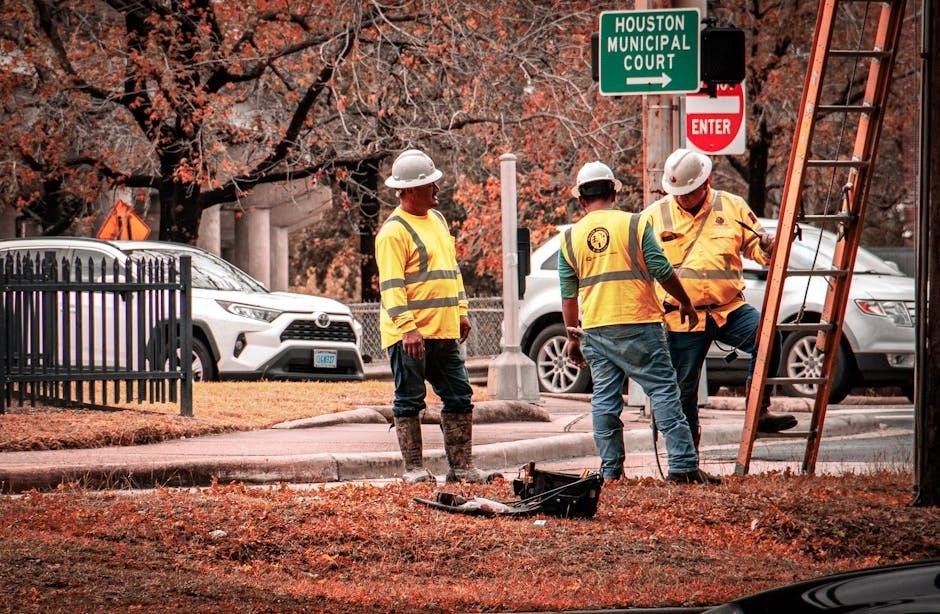
Technology and Data Analytics in Traffic Management
9.1 Smart Traffic Management Systems
Smart systems integrate real-time data from sensors‚ cameras‚ and GPS to optimize traffic signal timing‚ reducing congestion and improving traffic flow efficiently.
9.2 Big Data and Predictive Analytics in Traffic Planning
Advanced analytics leverage historical and real-time data to predict traffic patterns‚ enabling proactive planning and resource allocation for smoother urban mobility.
9.3 IoT Applications for Real-Time Traffic Monitoring
IoT devices collect and transmit data on traffic conditions‚ enabling dynamic adjustments to traffic signals and route recommendations to minimize delays and enhance safety.
Smart traffic management systems leverage advanced technologies to optimize traffic flow and reduce congestion. These systems integrate IoT sensors‚ real-time data analytics‚ and AI to monitor and manage traffic dynamically. By analyzing traffic patterns‚ they can adjust signal timings‚ divert traffic‚ and provide drivers with real-time updates. This approach enhances road safety‚ minimizes travel delays‚ and lowers emissions. Cities worldwide are adopting such systems to create intelligent transportation networks‚ ensuring efficient mobility and sustainable urban growth.
Big data and predictive analytics play a crucial role in modern traffic planning by enabling experts to analyze large datasets and forecast future traffic patterns. These tools help identify trends‚ optimize traffic signal timings‚ and improve infrastructure design. By leveraging historical and real-time data‚ predictive models can predict congestion hotspots‚ reducing travel delays. Advanced algorithms also support scenario planning‚ allowing planners to evaluate the impact of new developments or events on traffic flow. This data-driven approach enhances decision-making‚ ensuring more efficient and sustainable transportation systems.
IoT applications play a crucial role in real-time traffic monitoring by leveraging interconnected devices like sensors‚ cameras‚ and drones. These devices collect data on traffic volume‚ speed‚ and incidents‚ enabling instantaneous insights. Integration with traffic management systems allows for dynamic signal control and route optimization. IoT also supports predictive analytics‚ helping authorities anticipate congestion and implement proactive measures. Smart traffic lights and real-time information displays enhance driver decision-making‚ reducing bottlenecks. This technology not only improves traffic flow but also contributes to environmental sustainability by minimizing idle times and lowering emissions.
Legal and Policy Frameworks
Legal and policy frameworks govern traffic-generating developments through regulations‚ ensuring compliance with safety‚ environmental‚ and accessibility standards. These frameworks balance development growth with public interest protections and sustainability goals.
10.1 Traffic Impact Assessment Regulations
Traffic Impact Assessment (TIA) regulations are essential for evaluating how development projects affect road networks. These regulations require developers to analyze potential traffic increases‚ ensuring infrastructure can accommodate growth. TIAs typically involve data collection‚ traffic predictions‚ and mitigation strategies. Compliance ensures safety‚ reduces congestion‚ and minimizes environmental impacts. Authorities often mandate TIAs for large projects‚ like commercial or residential developments. By adhering to these regulations‚ planners balance development needs with sustainable traffic management‚ fostering efficient and safe transportation systems.
10.2 Zoning Laws and Traffic Generation
Zoning laws play a critical role in shaping traffic patterns by regulating land use and development density. These laws determine how properties can be used‚ influencing the types of businesses‚ housing‚ and infrastructure that contribute to traffic generation. By setting limits on development intensity‚ zoning laws can help reduce traffic congestion. They also promote mixed-use developments‚ which minimize the need for lengthy commutes. Additionally‚ zoning regulations can incentivize public transportation hubs and pedestrian-friendly designs‚ further mitigating traffic impacts. Effective zoning aligns land use with transportation goals‚ fostering sustainable and livable communities.
10.3 Environmental Impact of Traffic Generating Developments
Traffic generating developments significantly impact the environment‚ primarily through increased air pollution and greenhouse gas emissions. Vehicle emissions contribute to poor air quality‚ exacerbating respiratory issues and climate change. Noise pollution from traffic also affects urban ecosystems and human health. Additionally‚ increased road construction leads to habitat destruction and loss of biodiversity. Mitigating these impacts requires sustainable planning‚ such as promoting public transport‚ walkable neighborhoods‚ and non-motorized transportation options. Integrating environmental assessments into traffic planning ensures developments align with ecological preservation and climate goals.

Case Studies and Best Practices
Examining real-world examples of traffic management strategies highlights effective approaches.
- Successful projects demonstrate integrated land use and transport planning.
- Lessons learned emphasize the importance of data-driven decision-making.
- International best practices showcase innovative solutions for urban mobility.
These insights provide valuable guidance for future development strategies.
11.1 Successful Traffic Management Projects
Successful traffic management projects often combine innovative strategies with data-driven insights. For instance‚ cities like Singapore and London have implemented smart traffic systems‚ utilizing real-time data to optimize signal timings and reduce congestion. Other notable examples include bike-sharing programs in Paris and pedestrian-friendly urban designs in Copenhagen. These projects highlight the importance of integrating technology‚ public transport‚ and urban planning to create sustainable and efficient traffic solutions. They serve as benchmarks for future developments aiming to balance growth with mobility needs.
11.2 Lessons Learned from Traffic Generating Developments
Successful traffic generating developments highlight the importance of balancing growth with infrastructure capacity. Key lessons include the need for accurate traffic impact assessments to avoid underestimating demand. Integrating land use and transportation planning ensures sustainable outcomes. Public engagement helps address community concerns early‚ while flexible designs adapt to evolving travel patterns. Prioritizing alternative transportation options‚ such as walking and cycling‚ reduces reliance on cars. Finally‚ continuous monitoring and data-driven adjustments are crucial for long-term efficiency and safety.
- Data accuracy is critical for reliable predictions.
- Community involvement fosters acceptance and cooperation.
- Sustainability must be a core development principle.
11.3 International Best Practices in Traffic Management
International best practices in traffic management highlight innovative strategies from global cities. Singapore’s Electronic Road Pricing system effectively reduces congestion through dynamic pricing. Amsterdam and Copenhagen prioritize cycling infrastructure‚ lowering car dependency. Tokyo’s efficient public transport network minimizes traffic pressure. London’s Congestion Charge Zone demonstrates successful demand management. These cities integrate smart traffic systems‚ real-time data analytics‚ and sustainable urban planning to enhance mobility. Adopting such strategies can inspire other regions to address traffic challenges effectively‚ promoting safer‚ greener‚ and more efficient transportation networks.
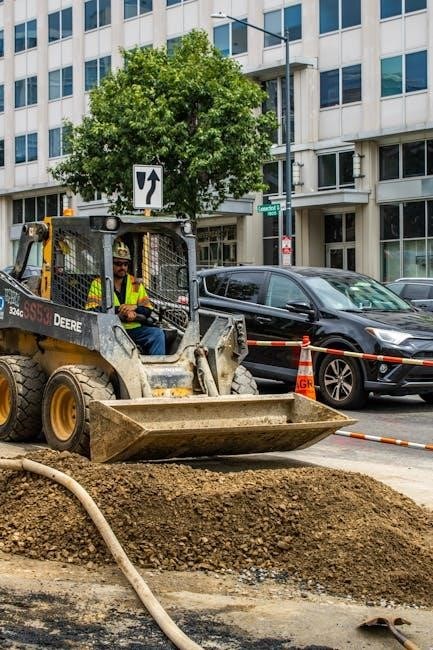
Future Trends in Traffic Generating Developments
Future trends include autonomous vehicles‚ smart infrastructure‚ and sustainable transportation solutions. 5G networks will enhance real-time traffic management‚ while electric vehicles reduce environmental impacts.
Increased focus on shared mobility and green spaces will reshape urban planning‚ promoting walkable cities and reducing traffic congestion. AI-driven systems optimize traffic flow and predict demand.
These innovations aim to create efficient‚ eco-friendly‚ and safer transportation networks‚ balancing growth with environmental and social responsibilities.
12.1 Impact of Autonomous Vehicles on Traffic
Autonomous vehicles (AVs) are revolutionizing traffic dynamics. By optimizing speed and spacing‚ AVs can enhance traffic flow‚ reducing congestion and accidents caused by human error. Shared autonomous mobility could decrease vehicle ownership‚ lowering traffic volume. However‚ increased accessibility might boost demand‚ potentially raising traffic levels. Mixed traffic scenarios‚ where AVs coexist with human-driven vehicles‚ pose challenges for smooth integration. The success of AVs in mitigating traffic depends on adoption rates‚ regulatory frameworks‚ and technological advancements. Balancing these factors is crucial for harnessing AVs’ full traffic-reducing potential.
12.2 Role of 5G Networks in Traffic Management
The integration of 5G networks into traffic management systems promises transformative advancements. With ultra-low latency and high-speed connectivity‚ 5G enables real-time data exchange between vehicles‚ infrastructure‚ and traffic control centers. This facilitates smarter traffic signal optimization‚ reducing congestion and improving safety. 5G also supports the Internet of Things (IoT) in traffic systems‚ enhancing sensor connectivity and data analytics. Additionally‚ 5G-powered technologies like autonomous vehicles and smart traffic lights can synchronize operations‚ creating more efficient urban mobility solutions. This connectivity is critical for future-proofing transportation networks and enhancing overall traffic flow efficiency.
12.3 Sustainable Transportation Solutions for Future Developments
Future developments must prioritize sustainable transportation solutions to reduce environmental impact and enhance mobility. Autonomous vehicles and electric vehicle (EV) infrastructure are key‚ offering cleaner alternatives to traditional transport. Public transit expansion‚ including high-capacity systems like light rail and bus rapid transit‚ can significantly lower emissions. Non-motorized transport‚ such as cycling and walking paths‚ encourages greener travel. Intermodal connectivity and smart growth strategies also play roles in creating efficient‚ low-impact transportation networks for tomorrow’s cities.
